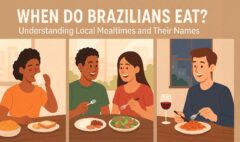Why Does the Interior of Northeast Brazil Have a History of Violence?
Why Does the Interior of Northeast Brazil Have a History of Violence?
The Historical Context of Conflict in Northeast Brazil
The settlement of Northeast Brazil has always been marked by disputes. Long before European colonization, indigenous tribes fought over territory for millennia. With the arrival of the Portuguese, these violent conflicts escalated. Indigenous groups clashed over regions with better access to food, both plant- and animal-based. In nomadic human groups, conflicts were common, likely dating back to the first humans in Brazil around 12,000 years ago.
Northeast Brazil’s Geographical Location
With Portuguese expansion, conflicts intensified. Aligning with stronger indigenous groups, the Portuguese formed armed indigenous militias to seize territories occupied by enemy tribes. This strategy was applied across Brazil, not just in the Northeast.
The Northeast is vast, and its settlement occurred at different times and in varied ways. The eastern Northeast, including Pernambuco, Paraíba, Alagoas, Sergipe, Rio Grande do Norte, and part of Bahia, played a central role in the first economic cycle: sugarcane cultivation.
The Sugar Economy and Slavery
Brazilwood extraction preceded sugarcane but was unsustainable due to a lack of replanting. Sugar production required vast land areas and a significant workforce. Initially, the Portuguese Crown opted for indigenous slavery. However, fearing an independent economy centered on native slave trade, Portugal banned indigenous slavery and enforced African slave imports. Portuguese companies profited by capturing and transporting Africans, while settlers paid high prices for enslaved labor. This system enriched both private enterprises and the Portuguese Crown while keeping the colony economically dependent.
Most African slaves worked on coastal sugar plantations. As Portuguese expansion moved north, conflicts with indigenous tribes were necessary to secure new land for sugar cultivation.
The Invasion of the Interior
Following the occupation of the coastal sugarcane regions, two fronts moved into the interior: one from the south via Bahia and another from the east to the west. Like the coastal takeover, the European invasion of the interior was violent. While the coast produced sugar for export, the interior developed agricultural estates for growing vegetables, fruits, and raising livestock.
One significant resistance movement against Portuguese expansion was the Confederation of the Cariris, also known as the War of the Barbarians. This coalition of indigenous groups fought colonial troops from 1682 to 1713. Like many coastal tribes, many indigenous groups in the interior faced total extermination.
The Rise of Coronelismo
The development of much of the Northeast’s interior happened with greater independence compared to the sugar-producing coast, which was closely monitored by Portuguese authorities. In the interior, with weaker Portuguese administrative oversight, landowners gained political, economic, and social dominance. This period saw the rise of coronelismo, a system where rural landowners controlled vast regions. Unlike the coast, where slave labor prevailed, the interior’s workforce consisted mainly of free laborers, including Portuguese New Christians—Jews forced to convert to Catholicism who hoped to practice their faith freely away from Portugal. However, religious orders like Jesuits, Carmelites, Benedictines, and Franciscans also settled in Brazil.
Quilombos: Refuge and Resistance
Many violent conflicts in the Northeast’s interior stemmed from the flight of enslaved people from sugar plantations and the formation of quilombos—communities of escaped slaves. These settlements also included indigenous people and poor white laborers fleeing exploitation. Quilombos were repeatedly established and destroyed in bloody wars, playing a crucial role in Brazil’s history of African slavery resistance.
The Cangaço: Social Banditry
In the 19th century, opposition to coronelismo gave rise to Cangaço, a form of social banditry. Cangaceiro groups looted farms and towns, challenging landowner dominance. The most feared and famous bandit leader was Virgulino Ferreira da Silva, known as Lampião. Cangaço persisted until the 1940s, leaving a lasting impact on the region’s history.
Political Transformations and Popular Revolts
With the expansion and diversification of the interior’s economy, social classes emerged. At the top of the hierarchy were coronels, followed by clergy members and colonial or imperial administrators. Conflicts frequently arose, particularly with slaves and small-scale farmers who leased land from powerful landowners.
Following Brazil’s independence in 1822, political reforms became necessary. Many small-scale producers and merchants suffered under regional political and landowner exploitation. A series of imperial laws introduced by Emperor Dom Pedro II triggered popular revolts, such as:
The Ronco da Abelha Rebellion (1851)
This uprising began in Paraíba and spread to neighboring provinces. The spark was the introduction of mandatory birth certificates, which the population saw as a tool for tracking and potentially enslaving the poor.
The Quebra-Quilos Revolt (1872)
In 1862, Brazil adopted the French metric system for measurements, weights, and capacities, primarily to standardize tax collection. By 1872, resistance erupted in Fagundes, near Campina Grande, Paraíba, and spread to Pernambuco, Alagoas, Bahia, Piauí, Ceará, and Rio Grande do Norte. Rebels destroyed official scales, stormed civil registry offices, and freed prisoners. The movement gained support from enslaved people, with Manuel do Carmo emerging as a leading black figure who transformed the rebellion into a fight for abolition and slave emancipation.
20th Century: The Rural Workers’ Movement
The most significant workers’ movement in the 20th century’s Northeast interior was The Peasant Leagues. Founded in Pernambuco in 1955 at Engenho Galileia, these leagues spread across the Northeast, Southeast, and Central-West regions. They fought against forced labor practices like cambão—mandatory unpaid labor on landowners’ estates.
The Sapé Peasant League (1958)
In 1958, João Pedro Teixeira, João Alfredo Dias, and Pedro Inácio de Araújo established the Sapé Peasant League, about 60 kilometers from João Pessoa, Paraíba. This became the largest peasant association, with around 10,000 rural workers. João Pedro Teixeira was assassinated by landowners in 1962, and the movement was brutally suppressed by Brazil’s military dictatorship after the 1964 coup.
Modern-Day Violence in Northeast Brazil
The Northeast interior, historically dry, arid, and socially divided, has been a stage for conflicts, rebellions, and wars since the Portuguese invasion. Over centuries, black, indigenous, and white populations endured violence in a region marked by deep inequalities.
Today, with urbanization and improved connectivity, the Northeast interior faces contemporary social challenges similar to other regions in Brazil, including drug trafficking, robberies, and homicides. Crime rates vary significantly from city to city, with some areas experiencing high levels of violence while others maintain lower crime rates.
Conclusion
Northeast Brazil’s history of violence is deeply rooted in its colonial past, economic structures, and social inequalities. From indigenous resistance and sugar plantation slavery to the rise of coronelismo, Cangaço, and peasant uprisings, the region has a long history of struggle. While modernization has brought new challenges, understanding this history is essential to grasp the region’s unique identity and resilience.
Learn Portuguese the Brazilian Way! 🇧🇷✨
At The Brazilian Ways, we believe language learning should be fun, immersive, and deeply connected to culture. Our unique courses help you speak Portuguese naturally while experiencing Brazil through its music, films, literature, and dance.
🎶 The Brazilian Music Club – Learn Portuguese through the rhythm and lyrics of Brazilian music.
🎬 The Movie Club – Improve your Portuguese while exploring the best of Brazilian cinema.
📖 The Short Story Club – Enhance your skills by diving into Brazilian literature.
💃 Portuguese for Zouk – Connect with the Zouk dance community while learning Portuguese.
✨ Join a vibrant community of learners and experience Brazil through language!
👉 Explore our programs and start today! 🚀
📲 Follow us on Instagram for more engaging content, language tips, and cultural insights: @thebrazilianways














